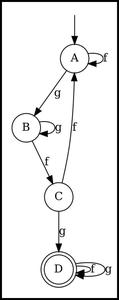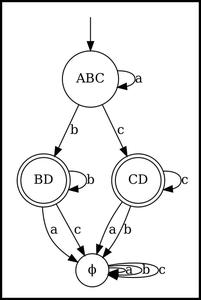使用Python和 Graphviz 将 Epsilon-NFA 转换为 DFA
有限自动机 (FA)是一种简单的机器,用于匹配输入字符串中的模式。有限自动机是一个五元组,即它有五个元素。在本文中,我们将了解如何使用Python和 Graphviz 将 epsilon-NFA 转换为 DFA。
FA 的五元组表示为:
![]()
五要素是:
- 有限状态集 (Q)
- 一组有限的输入字母 (
 )
) - 开始状态 (
 )
) - 一组有限的最终状态 (F)
- 转换函数(
 )
)
有限自动机(FA)有两种类型:
- 确定性有限自动机 (DFA)
- 非确定性有限自动机 (NFA)
有限自动机的类型:
确定性有限自动机 (DFA)
确定性有限自动机 (DFA)是一种 FA,其中对于转换函数中定义的输入字母表,机器只能进入一个固定状态。
DFA 不允许![]() (null) 字母表,这意味着如果没有检测到字母表,机器将不会改变状态。
(null) 字母表,这意味着如果没有检测到字母表,机器将不会改变状态。
对于 DFA,
![]()
例如,DFA 接受由 f 和 g 组成的所有字符串,其中包含“gfg”作为子字符串。

DFA
非确定性有限自动机 (NFA)
非确定性有限自动机 (NFA)是一种 FA,其中机器可以针对输入字母表进入多个状态。
对于 NFA,
![]()
NFA 允许![]() 移动称为E-NFA或Epsilon-NFA 。
移动称为E-NFA或Epsilon-NFA 。
NFA 允许![]() (null) 字母表意味着即使没有检测到输入字母表,机器也可以改变状态。
(null) 字母表意味着即使没有检测到输入字母表,机器也可以改变状态。
对于 E-NFA,
![]()
例如,NFA 接受由 f 和 g 组成的所有字符串,其中包含“gfg”作为子字符串。

NFA
这![]() 是因为,对于每个过渡,都有 2 种可能性,过渡或不过渡。这适用于每个 Q 状态。所以
是因为,对于每个过渡,都有 2 种可能性,过渡或不过渡。这适用于每个 Q 状态。所以![]() 将是每个转换的全部可能配置。
将是每个转换的全部可能配置。
为什么要转换?
计算机可以理解 FA 的基本形式,即 DFA。但是由于 NFA 的特性,我们人类可以轻松理解 NFA 和更好的 E-NFA。所以我们需要将 E-NFA 转换为 DFA。
将 E-NFA 转换为 DFA 的步骤:
![]() – 闭包:这是我们可以在没有任何输入的情况下进入的状态集,即
– 闭包:这是我们可以在没有任何输入的情况下进入的状态集,即![]() 移动。
移动。
第 1 步:查找![]() – NFA 开始状态的关闭,这将是 DFA 的开始状态。
– NFA 开始状态的关闭,这将是 DFA 的开始状态。
第 2 步:从这组开始,对每个字母表进行评估![]() – 关闭此字母表的转换集。
– 关闭此字母表的转换集。
步骤 3:对于我们遇到的每个新的闭包集合,我们将重复步骤 2,直到没有新的集合。
Step 4: DFA 中包含 NFA 最终状态的集合将成为最终集合状态。
例如,
让给定的 E-NFA 为:

NFA
NFA: ![]()
问:{A、B、C、D}
![]() : {a, b, c}
: {a, b, c}
![]() : 一种
: 一种
F:{D}
![]() :
:NFA a b c ![]()
A A – – BC B – BD – – C – – CD – D – – – –
它是一种语言的 NFA,它接受以下类型的字符串:{ ![]() , 在哪里
, 在哪里![]() }
}
转换步骤:
| States | |
| A | ABC |
| B | B |
| C | C |
| D | D |
第 1 步:查找![]() – NFA 开始状态的关闭,这将是 DFA 的开始状态。
– NFA 开始状态的关闭,这将是 DFA 的开始状态。
![]() – 关闭 NFA 的启动状态。
– 关闭 NFA 的启动状态。
![]() – 关闭 (A) : {A,B,C}
– 关闭 (A) : {A,B,C}
步骤 2,3:从这组开始,对于每个字母,评估![]() – 关闭此字母表的转换集。和 对于我们遇到的每一组新的闭包集,我们将重复步骤 2,直到没有新的集合被留下。
– 关闭此字母表的转换集。和 对于我们遇到的每一组新的闭包集,我们将重复步骤 2,直到没有新的集合被留下。
DFA 的当前状态集:{ABC}
- {ABC} -> a = A -> a : ABC
- {ABC} -> b = BD -> b : BD
- {ABC} -> c = CD -> c : CD
DFA 的当前状态集:{ABC, BD, CD}
- {BD} -> a =

- {BD} -> b = BD
- {BD} -> c =

- {CD} -> a =

- {CD} -> b =

- {CD} -> c = CD
DFA、Q 的国家:{ABC、BD、CD、 ![]() }
}
转移函数![]() :
:DFA a b c ABC ABC BD CD BD ![]()
BD ![]()
CD ![]()
![]()
CD ![]()
![]()
![]()
![]()
Step 4: DFA 中包含 NFA 最终状态的集合将成为最终集合状态。
D 是 NFA 的最终状态。因此,在其集合中包含 D 的所有状态都将是 DFA 中的最终状态。
所以 DFA, F 的最终状态:{BD, CD}
DFA 获得:

DFA
![]() 也称为死状态,因为它没有出边。所以机器到达死亡状态后,就无法到达最终状态。
也称为死状态,因为它没有出边。所以机器到达死亡状态后,就无法到达最终状态。
用代码实现的工具:
Graphviz:它是一个用于可视化图表的Python库。
要在Python中安装 graphviz,请在终端中运行以下命令:
pip install graphviz先决条件:
输入:
- 状态数: no_state
- 状态数组:状态
- 字母数量: no_alphabet
- 字母数组:字母
- 开始状态:开始
- 最终状态数: no_final
- 最终状态数组:决赛
- 转换次数: no_transition
- 转换数组:转换
转换的类型:[From State, Alphabet, To State]
效用 :
- 从状态获取索引的字典/映射: states_dict
- 字典/地图从字母表中获取索引: alphabets_dict
- 转换表字典从“状态”和“字母”对获取“到”状态数组: transition_table
- 存储 NFA 图形的 Digraph 对象: graph
方法/功能:
- NFA 类的构造函数: __init__()
它初始化所有输入变量并根据输入评估实用变量值。 - 从用户那里获取输入: fromUser()
获取用户输入的类方法。 - NFA 五元组的表示: __repr__()
- 查找状态的 Epsilon 闭包: getEpsilonClosure(state)
为了找到一个状态的 epsilon 闭包,我们维护一个堆栈来获取接下来要评估的状态,并维护一个字典来跟踪哪些状态已经被评估。
我们从 start 状态开始一个 while 循环,并找到它的 epsilon 转换状态。
我们将所有这些状态推送到堆栈 (stack.push(stata)) 并在字典中标记它们 (dict[state]=0)。
我们还在字典中将此状态标记为完整(dict[state]=1)。
对于每次下一次迭代,我们每次都弹出堆栈的顶部,如果没有通过检查字典来评估它,则对其进行评估。 - 从状态数组中为转换后的 DFA 图找到适当的状态名称: getStateName(state_list)
由于我们将从评估中获得状态列表,因此要在 DFA 图中显示,我们需要一个正确的名称,它将是集合中所有名称的串联。
例如:要状态设置为 ={A,B,D} ,则此函数将返回一个字符串= “ABD”。 - 检查数组是否包含 NFA 的最终状态以查找数组是否将是 DFA 中的最终状态: isFinalDFA(state_list)
此函数检查状态列表是否包含 NFA 中的最终状态,这反过来将判断该集合是否为最终状态。
例如:我们正在检查的集合是 = {A,B,D},并且 D 是 NFA 中的最终状态。所以这个函数将为这个输入集返回 True。所以这个集合将是 DFA 中的最终状态。
方法:
- 创建 NFA 类的对象: nfa ,并使用构造函数或使用用户输入将其初始化为预定义的值。
- 根据输入值用节点和边初始化nfa.graph 。
- 显示/渲染 NFA 图。
- 制作另一个 Digraph 对象来存储获得的 DFA 的值并渲染图表: dfa 。
- 评估 NFA 的所有状态的 epsilon 闭包以不每次都重新计算,并将其存储在字典中,键值对为 [state -> list of states ofclosure]: epsilon_closure{}
- 创建一个堆栈以跟踪接下来要评估的 DFA 状态: dfa_stack[]
- 添加 NFA 的起始状态的 epsilon 闭包作为 DFA 的起始状态。
- 制作一个列表以维护 DFA 中存在的所有状态: dfa_states[]
- 开始一个 while 循环,我们一直持续到 dfa_stack 中没有新状态为止。
- 我们弹出dfa_stack的顶部来评估当前状态集: cur_state。
- 我们遍历当前状态集的所有字母表。
- 我们创建一个集合来维护当前集合中所有状态的 epsilon 闭包: from_closure{}
- 如果这个集合不为空,
- 我们制作另一个集合来维护to_state集合。
- 如果该集合在dfa_states中不存在,那么我们将其附加到dfa_stack和dfa_states 中。
- 然后我们在dfa图中添加这个节点,并在cur_state和to_state 之间添加一条边。
- 否则这个集合是空的,那么
- 这种情况是死状态。
- 如果dfa中不存在死状态,那么我们添加新状态
 .我们将所有字母都转换为自身,这样机器就永远不会离开死状态。
.我们将所有字母都转换为自身,这样机器就永远不会离开死状态。 - 我们将cur_state转换为这个 dead_state。
- 最后,所有的状态都被评估了。所以我们将渲染/查看这个dfa图。
下面是完整的实现:
Python3
# Conversion of epsilon-NFA to DFA and visualization using Graphviz
from graphviz import Digraph
class NFA:
def __init__(self, no_state, states, no_alphabet, alphabets, start,
no_final, finals, no_transition, transitions):
self.no_state = no_state
self.states = states
self.no_alphabet = no_alphabet
self.alphabets = alphabets
# Adding epsilon alphabet to the list
# and incrementing the alphabet count
self.alphabets.append('e')
self.no_alphabet += 1
self.start = start
self.no_final = no_final
self.finals = finals
self.no_transition = no_transition
self.transitions = transitions
self.graph = Digraph()
# Dictionaries to get index of states or alphabets
self.states_dict = dict()
for i in range(self.no_state):
self.states_dict[self.states[i]] = i
self.alphabets_dict = dict()
for i in range(self.no_alphabet):
self.alphabets_dict[self.alphabets[i]] = i
# transition table is of the form
# [From State + Alphabet pair] -> [Set of To States]
self.transition_table = dict()
for i in range(self.no_state):
for j in range(self.no_alphabet):
self.transition_table[str(i)+str(j)] = []
for i in range(self.no_transition):
self.transition_table[str(self.states_dict[self.transitions[i][0]])
+ str(self.alphabets_dict[
self.transitions[i][1]])].append(
self.states_dict[self.transitions[i][2]])
# Method to get input from User
@classmethod
def fromUser(cls):
no_state = int(input("Number of States : "))
states = list(input("States : ").split())
no_alphabet = int(input("Number of Alphabets : "))
alphabets = list(input("Alphabets : ").split())
start = input("Start State : ")
no_final = int(input("Number of Final States : "))
finals = list(input("Final States : ").split())
no_transition = int(input("Number of Transitions : "))
transitions = list()
print("Enter Transitions (from alphabet to) (e for epsilon): ")
for i in range(no_transition):
transitions.append(input("-> ").split())
return cls(no_state, states, no_alphabet, alphabets, start,
no_final, finals, no_transition, transitions)
# Method to represent quintuple
def __repr__(self):
return "Q : " + str(self.states)+"\nΣ : "
+ str(self.alphabets)+"\nq0 : "
+ str(self.start)+"\nF : "+str(self.finals) + \
"\nδ : \n" + str(self.transition_table)
def getEpsilonClosure(self, state):
# Method to get Epsilon Closure of a state of NFA
# Make a dictionary to track if the state has been visited before
# And a array that will act as a stack to get the state to visit next
closure = dict()
closure[self.states_dict[state]] = 0
closure_stack = [self.states_dict[state]]
# While stack is not empty the loop will run
while (len(closure_stack) > 0):
# Get the top of stack that will be evaluated now
cur = closure_stack.pop(0)
# For the epsilon transition of that state,
# if not present in closure array then add to dict and push to stack
for x in self.transition_table[
str(cur)+str(self.alphabets_dict['e'])]:
if x not in closure.keys():
closure[x] = 0
closure_stack.append(x)
closure[cur] = 1
return closure.keys()
def getStateName(self, state_list):
# Get name from set of states to display in the final DFA diagram
name = ''
for x in state_list:
name += self.states[x]
return name
def isFinalDFA(self, state_list):
# Method to check if the set of state is final state in DFA
# by checking if any of the set is a final state in NFA
for x in state_list:
for y in self.finals:
if (x == self.states_dict[y]):
return True
return False
print("E-NFA to DFA")
# INPUT
# Number of States : no_state
# Array of States : states
# Number of Alphabets : no_alphabet
# Array of Alphabets : alphabets
# Start State : start
# Number of Final States : no_final
# Array of Final States : finals
# Number of Transitions : no_transition
# Array of Transitions : transitions
nfa = NFA(
4, # number of states
['A', 'B', 'C', 'D'], # array of states
3, # number of alphabets
['a', 'b', 'c'], # array of alphabets
'A', # start state
1, # number of final states
['D'], # array of final states
7, # number of transitions
[['A', 'a', 'A'], ['A', 'e', 'B'], ['B', 'b', 'B'],
['A', 'e', 'C'], ['C', 'c', 'C'], ['B', 'b', 'D'],
['C', 'c', 'D']]
# array of transitions with its element of type :
# [from state, alphabet, to state]
)
# nfa = NFA.fromUser() # To get input from user
# print(repr(nfa)) # To print the quintuple in console
# Making an object of Digraph to visualize NFA diagram
nfa.graph = Digraph()
# Adding states/nodes in NFA diagram
for x in nfa.states:
# If state is not a final state, then border shape is single circle
# Else it is double circle
if (x not in nfa.finals):
nfa.graph.attr('node', shape='circle')
nfa.graph.node(x)
else:
nfa.graph.attr('node', shape='doublecircle')
nfa.graph.node(x)
# Adding start state arrow in NFA diagram
nfa.graph.attr('node', shape='none')
nfa.graph.node('')
nfa.graph.edge('', nfa.start)
# Adding edge between states in NFA from the transitions array
for x in nfa.transitions:
nfa.graph.edge(x[0], x[2], label=('ε', x[1])[x[1] != 'e'])
# Makes a pdf with name nfa.graph.pdf and views the pdf
nfa.graph.render('nfa', view=True)
# Making an object of Digraph to visualize DFA diagram
dfa = Digraph()
# Finding epsilon closure beforehand so to not recalculate each time
epsilon_closure = dict()
for x in nfa.states:
epsilon_closure[x] = list(nfa.getEpsilonClosure(x))
# First state of DFA will be epsilon closure of start state of NFA
# This list will act as stack to maintain till when to evaluate the states
dfa_stack = list()
dfa_stack.append(epsilon_closure[nfa.start])
# Check if start state is the final state in DFA
if (nfa.isFinalDFA(dfa_stack[0])):
dfa.attr('node', shape='doublecircle')
else:
dfa.attr('node', shape='circle')
dfa.node(nfa.getStateName(dfa_stack[0]))
# Adding start state arrow to start state in DFA
dfa.attr('node', shape='none')
dfa.node('')
dfa.edge('', nfa.getStateName(dfa_stack[0]))
# List to store the states of DFA
dfa_states = list()
dfa_states.append(epsilon_closure[nfa.start])
# Loop will run till this stack is not empty
while (len(dfa_stack) > 0):
# Getting top of the stack for current evaluation
cur_state = dfa_stack.pop(0)
# Traversing through all the alphabets for evaluating transitions in DFA
for al in range((nfa.no_alphabet) - 1):
# Set to see if the epsilon closure of the set is empty or not
from_closure = set()
for x in cur_state:
# Performing Union update and adding all the new states in set
from_closure.update(
set(nfa.transition_table[str(x)+str(al)]))
# Check if epsilon closure of the new set is not empty
if (len(from_closure) > 0):
# Set for the To state set in DFA
to_state = set()
for x in list(from_closure):
to_state.update(set(epsilon_closure[nfa.states[x]]))
# Check if the to state already exists in DFA and if not then add it
if list(to_state) not in dfa_states:
dfa_stack.append(list(to_state))
dfa_states.append(list(to_state))
# Check if this set contains final state of NFA
# to get if this set will be final state in DFA
if (nfa.isFinalDFA(list(to_state))):
dfa.attr('node', shape='doublecircle')
else:
dfa.attr('node', shape='circle')
dfa.node(nfa.getStateName(list(to_state)))
# Adding edge between from state and to state
dfa.edge(nfa.getStateName(cur_state),
nfa.getStateName(list(to_state)),
label=nfa.alphabets[al])
# Else case for empty epsilon closure
# This is a dead state(ϕ) in DFA
else:
# Check if any dead state was present before this
# if not then make a new dead state ϕ
if (-1) not in dfa_states:
dfa.attr('node', shape='circle')
dfa.node('ϕ')
# For new dead state, add all transitions to itself,
# so that machine cannot leave the dead state
for alpha in range(nfa.no_alphabet - 1):
dfa.edge('ϕ', 'ϕ', nfa.alphabets[alpha])
# Adding -1 to list to mark that dead state is present
dfa_states.append(-1)
# Adding transition to dead state
dfa.edge(nfa.getStateName(cur_state,),
'ϕ', label = nfa.alphabets[al])
# Makes a pdf with name dfa.pdf and views the pdf
dfa.render('dfa', view = True)输出:

DFA
将 NFA 转换为 DFA 的算法复杂度:
时间复杂度: ![]()
空间复杂度: ![]()
其中,Q = NFA 的国家数量,N = NFA 的字母数量。